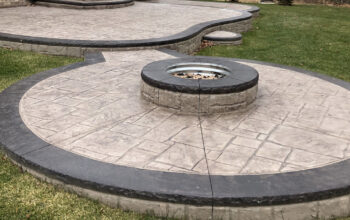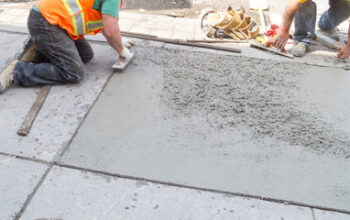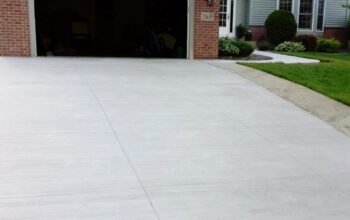The final look of your concrete project can be determined by the type of finish you select. There are several different types of concrete finishes available, each with its benefits and applications.
While the most basic type of concrete finish is a smooth surface produced with screeds and trowels, many clients want something a little more stylish and unique for their construction needs. Visit https://concretecontractorcoloradosprings.com/ to talk to an expert.
 Trowel Finish
Trowel Finish
Concrete is a versatile construction material that can be finished in a variety of ways to create unique aesthetics. Different finishing techniques will produce varying results, with some finishes creating a smooth surface while others give the concrete a rougher appearance. The trowel finish is the simplest and most common finish for new concrete and is usually used for sidewalks and patios. This finish is created by using a steel trowel (either manually or mechanically) to smooth the surface of the concrete once it has been placed, floated, and leveled.
This process can be done for both interior and exterior slabs and is the most popular choice for residential uses. This finish can be aesthetically pleasing and is a great option for homeowners who want a clean and modern look. This finish also requires minimal maintenance, with regular washing and occasional sealing being enough to keep it looking good.
The downside of this finish is that it can be difficult to clean, and the ridges created by the trowel can trap dirt and other debris. It is also possible for salt residue to linger on the surface, which can be problematic if the concrete is exposed to the elements.
Another disadvantage of this finish is that it is not as durable as other finishes. It can be easily damaged by traffic and heavy vehicles, and it may chip or crack more easily than other finishes. This is especially true if the concrete is left unprotected after construction.
Stencil Finish
Concrete is often thought of as being a grayish-white solid, but that’s not the case! You can paint concrete in a variety of different colors and textures. And, you can even have it patterned to look like other materials. This process is called stenciling. This type of finish is great for walkways, patios, and driveways.
With this technique, a stencil with a desired pattern is pressed against the concrete while it’s still curing. This allows for a wide range of patterns, such as bricks, tiles, stone, slate, wood, and more. The stencils can be colored as well to add more depth and make the pattern stand out even more.
The advantage of a stencil finish is that it hides imperfections in the concrete better than a smooth surface. It’s also a good choice for projects that require slip resistance. The only downside is that it can be difficult to clean because of the rough texture, especially if a large area is covered.
If you’re going to stencil, it’s best to prepare the surface before starting. Start by cleaning the concrete floor and applying a couple of coats of textured paint. Once the textured coat has dried, you can apply your stencil and begin painting. When painting, always use a soft brush and very light up-and-down movements. Any more pressure or a side-to-side motion will cause the paint to bleed underneath the stencil.
This is a time-consuming project, so be prepared to dedicate a few days to it. If you’re doing a large area, it’s also helpful to work in sections. This way, you can take a break now and then, and avoid the backache that comes with sitting or kneeling on concrete for long periods.
Shot Blasted Finish
A shot blast finish involves scrubbing away impurities and loose materials from the surface of hard surfaces using a variety of metal shots. This is a very effective technique for many different types of materials. It can remove rust, paint, and other surface contaminants to leave behind smooth surfaces that are ready for new coats of paint or other coatings. This method is often used in the construction industry to strip concrete floors for repair or resurfacing or in warehousing and storage to help keep floor surfaces clean and free of damage.
The quality of the media used in shot blasting has a huge impact on the results. It determines cleaning speed, surface roughness or texture after treatment, and the amount of abrasive consumed during the process. High-quality steel shoots and grits are more durable and transmit more energy into the material with each impact, so they last longer and require less overall media consumption.
Another important consideration when choosing the type of shot-blasting media to use is its shape, size, and density. The round-shaped shot has a much more gentle effect on the treated surface than angular or irregularly-shaped shots. The size of the shot is also critical; larger particles will provide a more aggressive blasting treatment than smaller ones.
The shot blasting process is carried out in a blast cabinet to prevent airborne contamination and reduce the health and safety risks for anyone overseeing the work. The abrasive blasting media is funneled into the system through valves and an air compressor. The abrasive is then propelled out through a blast nozzle and into the treatment area. The recycled media is then collected and returned via a filtration system to ensure minimal wastage.
Colored Finish
Functional finishes improve the performance of a part, such as increased wear resistance (nickel plating) or corrosion resistance (zinc plating). Cosmetic finishes include coatings like paint and powder coating.
Our custom blend of cementitious material, additives, aggregates, and pigment is designed to be used as the final coat in traditional two- or three-coat stucco systems. It meets the requirements and is available in 3,000 lb. bulk bags to work with our silo system.
Applied to polished, integrally colored, dyed, or stained concrete surfaces enhances the appearance of and extends the longevity of the surface by adding shine, stain resistance, and abrasion resistance. It is non-toxic, non-hazardous, and VOC-compliant in all areas of the world.
Salt Finish
The salt finish is another traditional concrete finish that is often used on pool decks and other wet areas. This finish is achieved by spreading coarse rock salt crystals over the surface of freshly poured concrete and then washing them off with streams of water once the concrete has set. This finish gives the concrete a rough subtle texture and skid resistance that is ideal for wet spaces.
The indentations created by the rock salt crystals give the concrete a speckled appearance that is similar to the look of pitted and weathered stone. This style of finish is also a popular choice for rustic and industrial projects, as it adds a sense of depth and character to the space. In addition, it hides imperfections like chips and cracks better than smooth or broom-finished concrete.
To achieve the best results, it is important to ensure that the concrete is completely dry before applying the rock salt crystals. The amount of salt that is applied will depend on the level of texture desired. For example, a light pattern will require less salt than a heavier one. The rock salt crystals should be spread evenly over the concrete and then pressed into it using rollers. For the best result, use salt crystals that are 1/8 to 3/8 of an inch in size. Avoid producing indents larger than this as they may be a hazard for people wearing shoes with pointed toes.
A salt finish is a cost-effective option that is easier to apply than decorative concrete finishes such as stamped or stenciled. It is also relatively fast to install and is a great choice for projects that need to be completed in a short time. However, it is important to remember that this type of finish does not hold up well in cold climates, as the divots can fill with water and freeze, which could damage the concrete.



